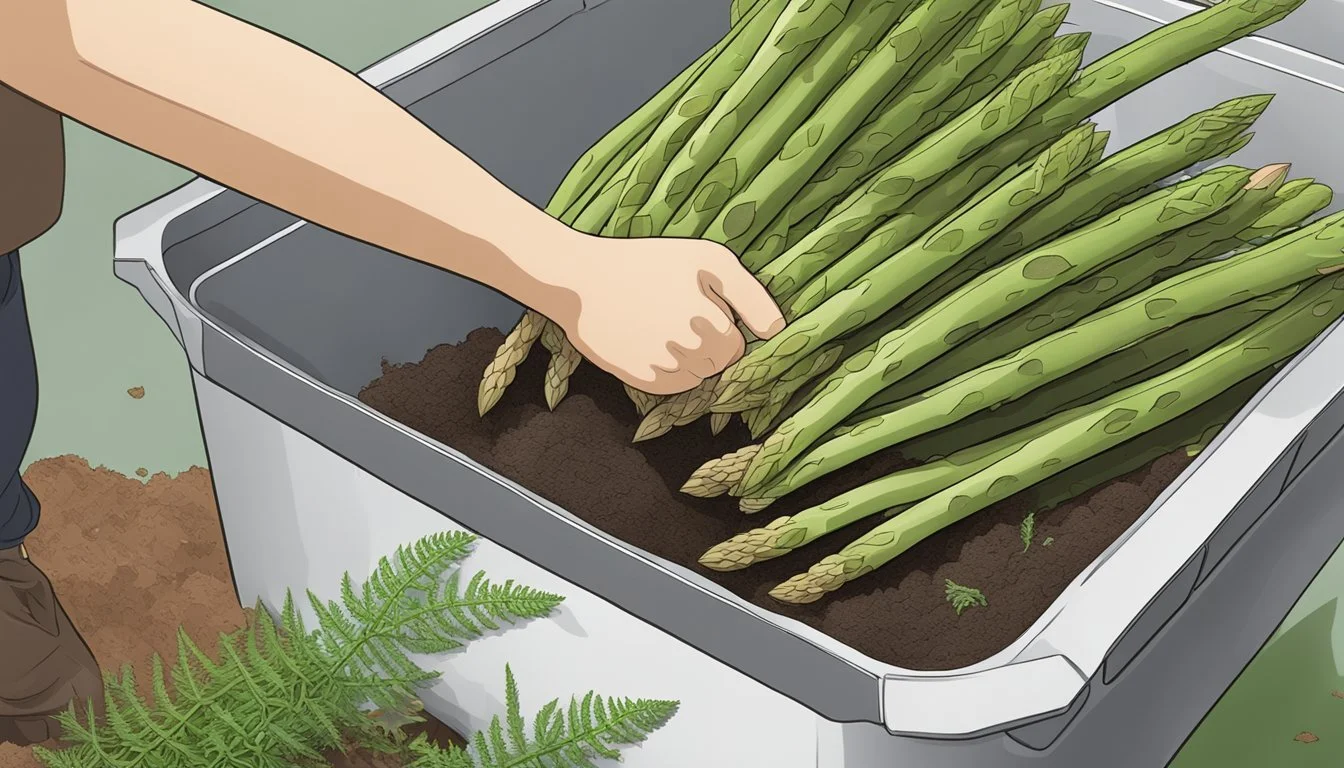Can You Compost Asparagus Ferns?
Understanding Their Compostability
Composting is a natural process of recycling organic matter such as leaves, kitchen scraps, and yard waste into a rich soil amendment known as compost. Asparagus (how long does asparagus last?) ferns, with their feathery foliage, can indeed be included in a compost pile. As they are organic in nature, these plants are biodegradable and can break down over time, enriching the compost with nutrients beneficial for garden health.
When adding asparagus (What wine goes well with asparagus?) ferns to compost, one should ensure they are not treated with pesticides or other chemicals that might harm the beneficial microbes in the compost pile. It's also wise to chop or break them into smaller pieces to accelerate the decomposition process. This is because the complex structure of fern leaves can take longer to break down than simpler, softer plant matter.
Proper balance in a compost pile is key; asparagus ferns should be mixed with a variety of other greens (nitrogen-rich materials) and browns (carbon-rich materials) to create a well-rounded compost. Browns can include dry leaves or paper, while other greens might be vegetable scraps or coffee grounds. This balance helps to maintain an efficient composting environment, leading to a nutrient-rich end product ideal for garden use.
Asparagus Fern Overview
While commonly termed ferns, asparagus ferns are indeed part of the lily family and not true ferns. They are favored for their delicate, feathery foliage and ease of care in varying environments.
Types and Characteristics
Asparagus setaceus, also known as the lace fern or Asparagus plumosus, is renowned for its fine, lacy foliage. Asparagus densiflorus is known by several names including the foxtail fern or emerald fern due to its dense, bushy fronds that resemble a foxtail. These perennials have 'fronds' which are actually long stems called cladodes, that provide photosynthesis in place of leaves.
Environmental Preferences
Asparagus ferns prosper in zones 9 to 11, thriving in moist, well-draining soil with a neutral pH. They prefer environments with high humidity and bright, indirect light. They should be protected from direct sunlight to avoid scorching, but they enjoy warm conditions reminiscent of their native habitats.
Growth and Life Cycle
An asparagus fern's growth is fast-paced during the growing season which spans spring and summer. As warm-weather perennials, they may produce small flowers followed by berries. Their rapid development accentuates their use as ornamental plants both indoors and in outdoor gardens, where they can adapt to dappled or partial shade.
Cultivation and Care
Cultivation and care of asparagus ferns involve specific practices that ensure healthy growth and plant vitality. This section covers essential guidelines on planting, watering, light requirements, and maintenance to help gardeners and indoor plant enthusiasts nurture their asparagus ferns effectively.
Planting and Potting
When planting asparagus ferns, choose a container with adequate drainage holes to prevent waterlogging. Use well-draining, organically rich potting soil to provide a supportive foundation for the roots. For outdoor garden planting, ensure the location allows for ample space as the ferns can spread significantly.
Watering and Feeding
Asparagus ferns require consistent moisture—water the plant whenever the top 2 inches of soil feel dry. However, avoid overwatering to prevent root rot. During the growing season, feeding with a balanced liquid fertilizer every few weeks provides the necessary nutrients to sustain healthy foliage.
Light and Temperature Requirements
These ferns thrive in bright indirect light, making them well-suited for less sunny indoor spaces or partially shaded areas in the garden. They prefer a temperature range of 65-80°F and high humidity, which is typical of their native environments like Florida, Texas, and Hawaii.
Pruning and Maintenance
Regular pruning helps maintain an attractive shape and encourages dense foliage growth. Remove any yellowing or dead leaves to keep the plant healthy. Asparagus ferns are generally easy to grow and benefit from an annual check of their pH levels, which should ideally remain slightly acidic, between 6.5 and 6.8.
Propagation Techniques
Asparagus ferns can be propagated through two main methods, each with specific steps for successful growth. The techniques of propagation through division and growing from cuttings and seeds offer gardeners flexibility based on their preferences and the resources they have available.
Propagation through Division
Propagation division is ideal for asparagus ferns due to their tuberous root system. Gardeners should:
Select mature plants: Ones with several stems are optimal for division.
Remove from pots carefully: Avoid damage to the tuberous roots, which can exacerbate root rot problems.
Divide into clumps: Each clump should have multiple roots.
Repot into fresh soil: Use well-draining potting mix to encourage healthy growth and lessen the risk of root rot.
Growing from Cuttings and Seeds
Cuttings are less commonly used for propagating asparagus ferns, but they offer an alternative method:
Take stem cuttings: Preferably from a healthy and established plant.
Prepare cutting: Ensure it has at least one node, as this is where new growth will emerge.
Root in water or soil: Change water weekly to prevent algae or plant directly into a pot with fresh soil.
For seeds, the gardener should:
Collect seeds: These are found in the berries of a mature asparagus fern.
Sow in moist soil: Plant in well-draining potting mix.
Provide warmth: Maintain a temperature around 70°F (21°C) to encourage germination.
Germinate: Seeds may take several weeks to germinate. Patience is key.
Common Issues and Solutions
When composting asparagus ferns, one must consider potential challenges such as pests and diseases, as well as environmental stresses that can affect the decomposition process. These issues can be addressed with proper knowledge and proactive measures.
Pests and Diseases
Asparagus ferns are susceptible to various pests such as spider mites, mealybugs, and aphids. These pests can hinder the composting process by damaging the ferns before they break down.
Spider mites cause yellowing and stippling on leaves.
Solution: Increase humidity around the plant or apply insecticidal soap.
Mealybugs and aphids suck sap from the stems and leaves.
Solution: Use neem oil or a strong water spray to dislodge and kill these pests.
Plant diseases like root rot can arise, especially when the asparagus fern is kept as a houseplant with inadequate drainage.
Symptoms: Brown, mushy roots and yellowing leaves.
Solution: Ensure proper drainage and avoid overwatering to prevent root rot.
Environmental Stress
Environmental stress factors such as inadequate light, extreme temperatures, and incorrect moisture levels can impact the health of asparagus ferns, making them less suitable for composting.
Humidity: Asparagus fern prefers higher humidity levels.
Solution: Mist the plant regularly or use a humidifier.
Outdoor vs. Houseplant: Plants grown outside may adapt to colder temperatures, but those kept indoors need consistent temperatures.
Solution: Protect outdoor plants from frost and maintain moderate temperatures for houseplants.
By managing these issues, asparagus ferns can be composted effectively, turning potential waste into rich soil amendment.
Safety and Precautions
When composting asparagus ferns, one should be aware of the plant's potential toxicity, particularly when it concerns the health of humans and pets.
Toxicity to Humans and Pets
The asparagus fern, while not a true fern, has certain parts that are toxic. It produces berries that can be harmful if ingested. Pets, specifically cats and dogs, may experience gastrointestinal discomfort and potential health risks from these berries. In humans, contact with the asparagus fern's sap can cause skin irritation, so it's advisable to wear gloves when handling the plant to avoid any allergic reactions or dermatitis.
Here is a summarized list of precautions:
Wear gloves: to prevent skin irritation from sap.
Keep away from pets: prevent pets from ingesting the berries.
Inform family members: make sure that all individuals in the household are aware of the asparagus fern's potential toxicity, especially if they will be involved in handling the plant or waste.
When composting asparagus ferns, these safety measures help protect one's family and pets while turning the plant into a beneficial addition to garden soil.
Miscellaneous Information
In this section, we explore the diverse roles of asparagus ferns in landscaping and delve into their cultural significance. These aspects highlight the fern's adaptability and historical ties.
Asparagus Fern in Landscaping
Asparagus ferns, particularly varieties such as Asparagus densiflorus 'Sprengeri'—often referred to as the emerald fern or sprengeri fern—are appreciated for their feathery, light foliage, which adds texture and greenery to landscapes. They are widely used in containers, hanging baskets, and as groundcover. However, caution is advised as they can be invasive in certain climates, growing aggressively and potentially disrupting local ecosystems.
Advantages in landscapes:
Aesthetic appeal with soft, plume-like foliage.
Acts as filler plants, offering a lush backdrop for flowering companions.
Challenges:
Can spread uncontrollably if not managed, leading to a difficult removal process.
In some regions, repotting is recommended to contain growth.
Asparagus densiflorus can also produce red berries, which may add a pop of color but are toxic upon ingestion and could pose a risk to children and pets.
Cultural Significance
As a member of the Asparagaceae family, asparagus ferns hold various cultural meanings. They are often associated with fascination and a sense of belonging, likely due to their binding and sprawling growth patterns. Historically, these ferns have been used in festive decorations and garlands, symbolizing eternal youth with their evergreen nature.
Representations:
Symbolize enduring youth and fascination in cultural lore.
Used as traditional decor, signifying unity and togetherness.
It's key to note that while commonly termed 'fern', asparagus ferns are not true ferns, and this misnomer is significant in understanding both their care requirements and place in plant taxonomy.





